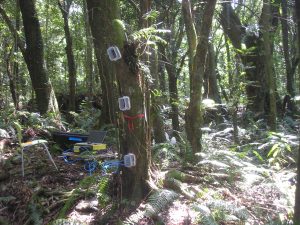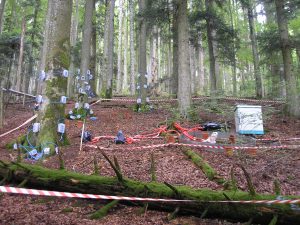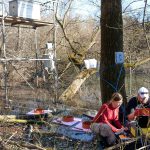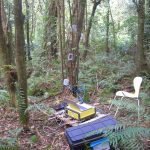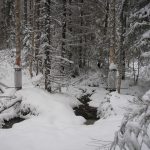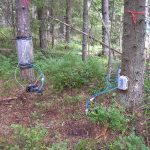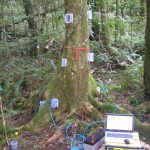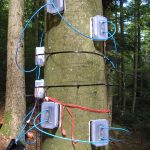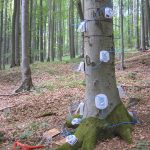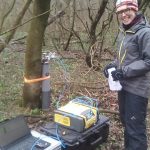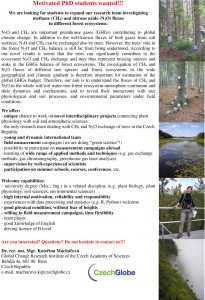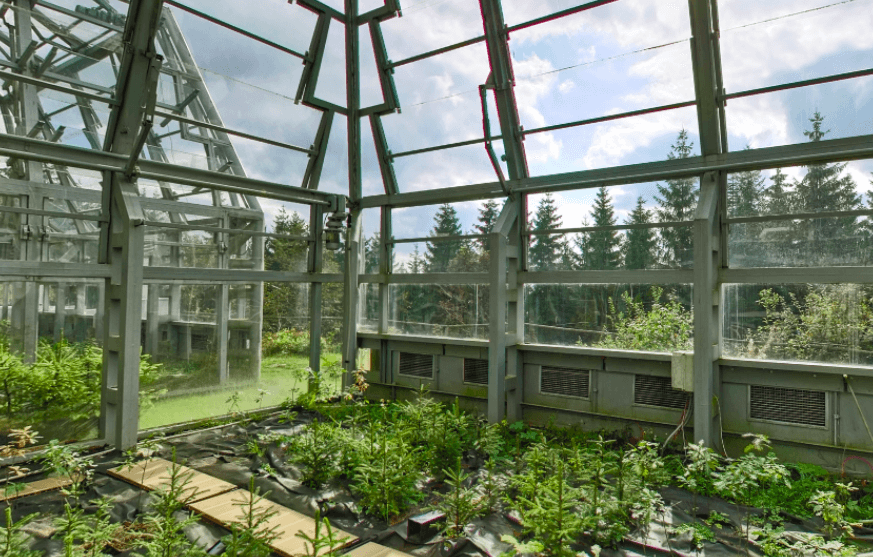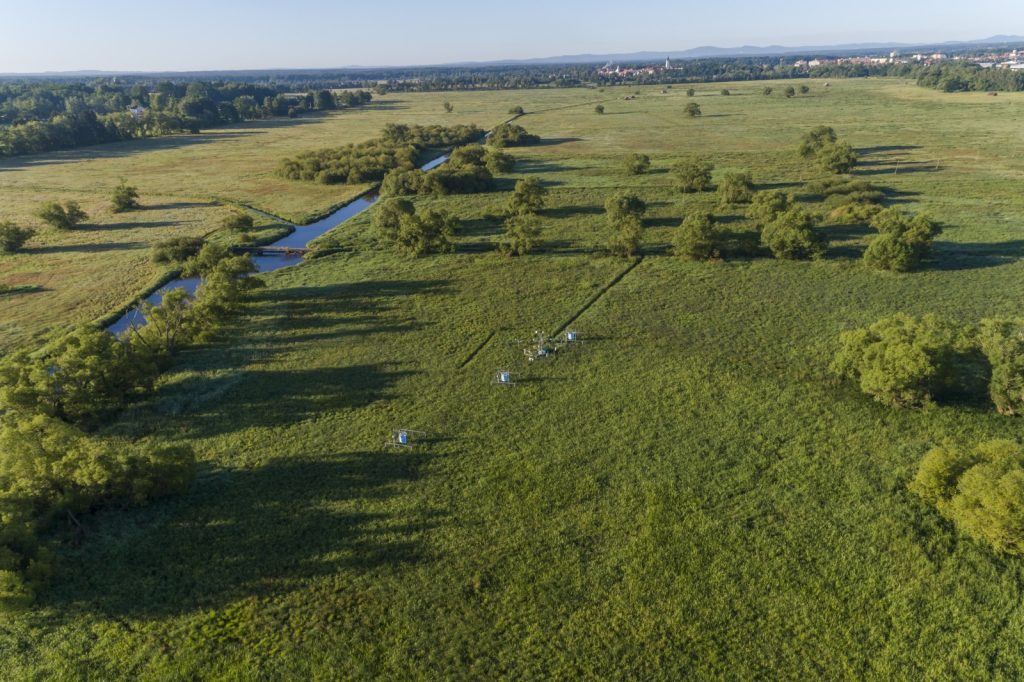Dr. rer. nat. Mgr. Kateřina Macháčová – head
Scientists:
prof. Dr. Ülo Mander
M.Sc. Thomas Schindler, Ph.D.
Dr. rer. nat. Hannes Warlo
The Department of Ecosystem Trace Gas Exchange investigates the exchange of important greenhouse gases (GHGs) – methane (CH4) and nitrous oxide (N2O) – in different tree species and forest ecosystems along a wide geographical and climatic gradient. Fluxes of CH4 and N2O from soils are well known and have been predominantly investigated. Both gases can be exchanged also by trees, however, the trees’ role in the forest CH4 and N2O balance is still far from being understood.
Areas of research include:
We focus our research activities on quantification of fluxes of N2O, CH4 and to a lesser extent also carbon dioxide – CO2 (indicator of physiological activity) in soils, mature trees of various tree species (roots, stems, leaves), cryptogamic stem covers (i.e. photoautotrophic organisms grown on tree bark) and in different forest ecosystems. Hereby, our interdisciplinary approach combines tree ecological physiology with soil and atmospheric sciences. This allows us to study CH4 and N2O cycling, flux dynamics and their mechanisms in the whole soil/water-tree-ecosystem-atmosphere continuum. Clarifying the role of trees in the GHGs exchange of different forest ecosystems is the prerequisite for correct estimations of the ecosystem CH4 and N2O budgets and therefore of global GHG flux inventories. Revealed impacts of environmental parameters on trace gas fluxes will then help to predict the future global climate change.
Main objectives of the department:
a) characterisation and quantification of fluxes of CH4, N2O and CO2 from mature trees of different tree species and soils in various forest ecosystems
b) study of tree exchange mechanisms incl. newly detected role of trees as sinks of CH4 and N2O, and interaction between GHGs exchange of trees and their physiological activity and environmental parameters
c) investigation of spatial and temporal (seasonal, daily) variability of tree fluxes and estimation of seasonal and annual forest ecosystem CH4 and N2O budgets
d) clarification of the trees’ role in GHGs exchange of different forest ecosystems
e) development of new measurement systems and methods
Long-term goals of the department:
a) providing a first comprehensive overview of CH4 and N2O cycling and flux dynamics in the whole soil/soil water-tree-forest ecosystem-atmosphere continuum
b) identification of missing sources and sinks of CH4 and N2O in forest ecosystem GHGs budgets
c) finding of common characteristics of trees` pathways of CH4 and N2O fluxes for individual tree species groups (e.g. upland vs. wetland tree species, broad-leaf trees vs. conifers)
d) application of our knowledge and research outputs in the water/forest/landscape/agricultural management and economic assessment of ecosystem services
Used infrastructure:
1) two portable FTIR gas analysers (Fourier transform infrared spectrometers) for detection of CO2, CH4, N2O, CO, NH3, NO, and NO2
2) gas chromatograph equipped for detection of CO2, CH4 and N2O
3) static chamber systems (tree stem, root and shoot chambers, soil chambers; own development) for investigation of trace gas fluxes from tree compartments and soils of various forests of all main climatic zones (various requirements and conditions)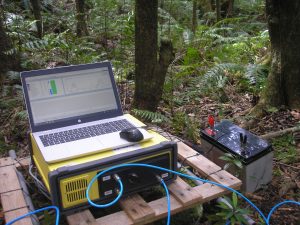
4) gas exchange measurement methods and protocols
5) various devices/instrumentation for ancillary field measurements
6) thanks to our broad international collaborations, we have free access to excellent and for our research field unique experimental forest stations in various climatic zones
Most important research outputs:
Our research team has gained new insights in the CH4 and N2O exchange of different tree species. For the first time we defined: i) strong seasonality in tree CH4 and N2O fluxes in (hemi-) boreal forests, ii) different tree species of boreal, temperate and tropical forests as possible CH4 and N2O sinks (i.e. gas uptake from the atmosphere), iii) cryptogamic stem covers as sinks of N2O, iv) tropical rain forest on lava flow as important CH4 sink, and v) importance of leaves/shoots in tree CH4 and N2O exchange.
Photogallery
Most important publications:
Schindler T, Mander U, Machacova K, Espenberg M, Krasnov D, Escuer-Gatius J, Veber G, Pärn J, Soosaar K (2020) Short-term flooding increases CH4 and N2O emissions from trees in a riparian forest soil-stem continuum.
Scientific Reports 10, 3204. https://doi.org/10.1038/s41598-020-60058-7
Machacova K, Vainio E, Urban O, Pihlatie M (2019) Seasonal dynamics of stem N2O exchange follow the physiological activity of boreal trees. Nature Communications 10: 4989, DOI: 10.1038/s41467-019-12976-y
Maier M, Machacova K, Svobodova K, Urban O, Lang F (2018) Combining soil and tree-stem flux measurements and soil gas profiles to understand CH4 pathways in Fagus sylvatica forests. Journal of Plant Nutrition and Soil Science 181: 31–35, DOI: 10.1002/jpln.201600405.
Machacova K, Maier M, Svobodova K, Lang F, Urban O (2017) Cryptogamic stem covers may contribute to nitrous oxide consumption by mature beech trees. Scientific Reports 7: 13243, DOI: 10.1038/s41598-017-13781-7.
Machacova K, Bäck J, Vanhatalo A, Halmeenmäki E, Kolari P, Mammarella I, Pumpanen J, Acosta M, Urban O, Pihlatie M (2016) Pinus sylvestris as a missing source of nitrous oxide and methane in boreal forest. Scientific Reports 6, 23410, DOI: 10.1038/srep23410.
Motivated PhD students wanted!!!

